Human Oral Mucosa as a Potentially Effective Source of Neural Crest Stem Cells for Clinical Practice
Abstract
:1. Introduction
2. Material and Methods
2.1. Setting of Human Research
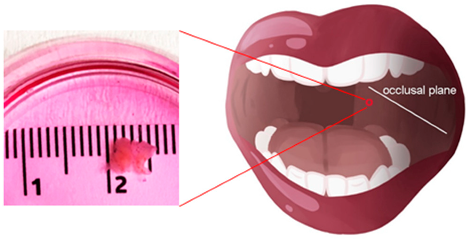
2.2. Cell Isolation and Culture
2.3. RNA Sequencing
2.3.1. Library Construction and Sequencing
2.3.2. Bioinformatics and Data Analysis
2.3.3. Western Blot Analysis
2.3.4. Statistics
3. Results
3.1. Oral Mucosa Epithelial Cell Isolation and Expansion
3.2. Characterization of NCSCs Isolated and Expanded from Oral Mucosa
4. Discussion
4.1. Neural Crest Stem Cell
4.2. Autologous Oral Mucosa Epithelium and Clinical-Grade Reagents for the Isolation and Expansion of NCSCs
4.3. Genes Expression Specific to Neural Crest Stem Cells
4.4. Oral Mucosa Epithelium as a Source of Neural Crest Stem Cells
5. Conclusions
Author Contributions
Funding
Institutional Review Board Statement
Informed Consent Statement
Data Availability Statement
Conflicts of Interest
References
- Yang, J.; Tyler, L.W.; Donoff, R.B.; Song, B.; Torio, A.J.; Gallagher, G.T.; Tsuji, T.; Elovic, A.; McBride, J.; Yung, C.M.; et al. Salivary EGF regulates eosinophil-derived TGF-alpha expression in hamster oral wounds. Am. J. Physiol. Liver Physiol. 1996, 270 Pt 1, G191–G202. [Google Scholar] [CrossRef] [PubMed]
- Abu Eid, R.; Sawair, F.; Landini, G.; Saku, T. Age and the architecture of oral mucosa. Age 2012, 34, 651–658. [Google Scholar] [CrossRef]
- López, S.; Hoz, L.; Tenorio, E.P.; Buentello, B.; Magaña, F.S.; Wintergerst, A.; Navas, A.; Garfias, Y.; Arzate, H. Can Human Oral Mucosa Stem Cells Differentiate to Corneal Epithelia? Int. J. Mol. Sci. 2021, 22, 5976. [Google Scholar] [CrossRef]
- Lee, J.; Shin, D.; Roh, J.-L. Use of a pre-vascularised oral mucosa cell sheet for promoting cutaneous burn wound healing. Theranostics 2018, 8, 5703–5712. [Google Scholar] [CrossRef]
- Yamaguchi, N.; Isomoto, H.; Kobayashi, S.; Kanai, N.; Kanetaka, K.; Sakai, Y.; Kasai, Y.; Takagi, R.; Ohki, T.; Fukuda, H.; et al. Oral epithelial cell sheets engraftment for esophageal strictures after endoscopic submucosa dissection of squamous cell carcinoma and airplane transportation. Sci. Rep. 2017, 7, 17460. [Google Scholar] [CrossRef]
- Marynka-Kalmani, K.; Treves, S.; Yafee, M.; Rachima, H.; Gafni, Y.; Cohen, M.A.; Pitaru, S. The Lamina Propria of Adult Human Oral Mucosa Harbors a Novel Stem Cell Population. Stem Cells 2010, 28, 984–995. [Google Scholar] [CrossRef]
- Gao, Y.; Zhao, G.; Li, D.; Chen, X.; Pang, J.; Ke, J. Isolation and Multiple Differentiation Potential Assessment of Human Gingival Mesenchymal Stem Cells. Int. J. Mol. Sci. 2014, 15, 20982–20996. [Google Scholar] [CrossRef]
- Treves-Manusevitz, S.; Hoz, L.; Rachima, H.; Montoya, G.; Tzur, E.; Vardimon, A.; Narayanan, A.S.; Amar, S.; Arzate, H.; Pitaru, S. Stem cells of the lamina propria of human oral mucosa and gingiva develop into mineralized tissues in vivo. J. Clin. Periodontol. 2013, 40, 73–81. [Google Scholar] [CrossRef]
- Arroyo, R.; López, S.; Romo, E.; Montoya, G.; Hoz, L.; Pedraza, C.; Garfias, Y.; Arzate, H. Carboxy-Terminal Cementum Protein 1-Derived Peptide 4 [cemp1-p4] Promotes Mineralization through wnt/β-catenin Signaling in Human Oral Mucosa Stem Cells. Int. J. Mol. Sci. 2020, 21, 1307. [Google Scholar] [CrossRef]
- Ganz, J.; Arie, I.; Buch, S.; Zur, T.B.; Barhum, Y.; Pour, S.; Araidy, S.; Pitaru, S.; Offen, D. Dopaminergic-Like Neurons Derived from Oral Mucosa Stem Cells by Developmental Cues Improve Symptoms in the Hemi-Parkinsonian Rat Mode. PLoS ONE 2014, 9, e100445. [Google Scholar] [CrossRef]
- Ganz, J.; Arie, I.; Ben-Zur, T.; Dadon-Nachum, M.; Pour, S.; Araidy, S.; Pitaru, S.; Offen, D. Astrocyte-Like Cells Derived from Human Oral Mucosa Stem Cells Provide Neuroprotection In Vitro and In Vivo. Stem Cells Transl. Med. 2014, 3, 375–386. [Google Scholar] [CrossRef] [PubMed]
- Kuperman, S.; Efraty, R.; Arie, I.; Rahmanov, A.; Gavrielov, M.R.; Noff, M.; Fishel, R.; Pitaru, S. Examination of the Therapeutic Potential of Mouse Oral Mucosa Stem Cells in a Wound-Healing Diabetic Mice Model. Int. J. Environ. Res. Public Health 2020, 17, 4854. [Google Scholar] [CrossRef] [PubMed]
- Kent, I.; Jahansouz, C.; Ghuman, A.; Shpitz, B.; Kidron, D.; Yaffe, V.; El-Naaj, I.A.; Araidy, S.; Reina, L.; Pitaru, S.; et al. Human Oral Mucosa Stem Cells Reduce Anastomotic Leak in an Animal Model of Colonic Surgery. Eur. Surg Res. 2021, 62, 32–39. [Google Scholar] [CrossRef] [PubMed]
- Ganz, J.; Shor, E.; Guo, S.; Sheinin, A.; Arie, I.; Michaelevski, I.; Pitaru, S.; Offen, D.; Levenberg, S. Implantation of 3D Constructs Embedded with Oral Mucosa-Derived Cells Induces Functional Recovery in Rats with Complete Spinal Cord Transection. Front. Neurosci. 2017, 1, 589. [Google Scholar] [CrossRef]
- Medina-Cuadra, L.; Monsoro-Burq, A.H. Xenopus, an emerging model for studying pathologies of the neural crest. Curr. Top. Dev. Biol. 2021, 145, 313–348. [Google Scholar] [CrossRef]
- Mehrotra, P.; Tseropoulos, G.; Bronner, M.E.; Andreadis, S.T. Adult tissue-derived neural crest-like stem cells: Sources, regulatory networks, and translational potential. Stem Cells Transl. Med. 2020, 9, 328–341. [Google Scholar] [CrossRef]
- Patel, I.; Parchem, R.J. Regulation of Oct4 in stem cells and neural crest cells. Birth Defects Res. 2022, 114, 983–1002. [Google Scholar] [CrossRef]
- Narwani, K.; Stark, J.; Cortez, D.; Yang, I.; Au, C.; Diaz, A.; Guerra, C.; Niihara, Y.; Bardag-Gorce, F. cG-CAOMECS-clinical-grade cultured autologous oral mucosa epithelial cell sheet. Cell Tissue Res. 2021, 386, 47–57. [Google Scholar] [CrossRef]
- Taihi, I.; Pilon, C.; Cohen, J.; Berdal, A.; Gogly, B.; Nassif, A.; Fournier, B.P. Efficient isolation of human gingival stem cells in a new serum-free medium supplemented with platelet lysate and growth hormone for osteogenic differentiation enhancement. Stem Cell Res. Ther. 2022, 13, 125. [Google Scholar] [CrossRef]
- Dobin, A.; Davis, C.A.; Schlesinger, F.; Drenkow, J.; Zaleski, C.; Jha, S.; Batut, P.; Chaisson, M.; Gingeras, T.R. STAR: Ultrafast universal RNA-seq aligner. Bioinformatics 2013, 29, 15–21. [Google Scholar] [CrossRef]
- Partek® Flow® Software, v7.0; Partek Inc.: St. Louis, MO, USA, 2019.
- Love, M.I.; Huber, W.; Anders, S. Moderated estimation of fold change and dispersion for RNA-seq data with DESeq2. Genome Biol. 2014, 15, 550. [Google Scholar] [CrossRef] [PubMed]
- Krämer, A.; Green, J.; Pollard, J., Jr.; Tugendreich, S. IPA: Causal analysis approaches in Ingenuity Pathway Analysis. Bioinformatics 2014, 30, 523–530. [Google Scholar] [CrossRef] [PubMed]
- Li, Q.; Yin, L.; Jones, L.W.; Chu, G.C.-Y.; Wu, J.B.-Y.; Huang, J.-M.; Li, Q.; You, S.; Kim, J.; Lu, Y.-T.; et al. Keratin 13 expression reprograms bone and brain metastases of human prostate cancer cells. Oncotarget 2016, 7, 84645–84657. [Google Scholar] [CrossRef] [PubMed]
- Bose, A.; Teh, M.-T.; Mackenzie, I.C.; Waseem, A. Keratin K15 as a Biomarker of Epidermal Stem Cells. Int. J. Mol. Sci. 2013, 14, 19385–19398. [Google Scholar] [CrossRef] [PubMed]
- Alsaegh, M.A.; Al Shayeb, M.; Varma, S.R.; Altaie, A.M.; Zhu, S. The correlated expression of COX-2 and keratin 15 in radicular cysts. J. Clin. Exp. Dent. 2022, 14, e334–e340. [Google Scholar] [CrossRef]
- Dudás, J.; Ladányi, A.; Ingruber, J.; Steinbichler, T.B.; Riechelmann, H. Epithelial to Mesenchymal Transition: A Mechanism that Fuels Cancer Radio/Chemoresistance. Cells 2020, 9, 428. [Google Scholar] [CrossRef]
- Wislet, S.; Vandervelden, G.; Rogister, B. From Neural Crest Development to Cancer and Vice Versa: How p75NTR and (Pro)neurotrophins Could Act on Cell Migration and Invasion? Front. Mol. Neurosci. 2018, 11, 244. [Google Scholar] [CrossRef]
- Heuer, J.G.; Fatemie-Nainie, S.; Wheeler, E.F.; Bothwell, M. Structure and developmental expression of the chicken NGF receptor. Dev. Biol. 1990, 137, 287–304. [Google Scholar] [CrossRef]
- Rothstein, M.; Simoes-Costa, M. Heterodimerization of TFAP2 pioneer factors drives epigenomic remodeling during neural crest specification. Genome Res. 2020, 30, 35–48. [Google Scholar] [CrossRef]
- Schock, E.N.; LaBonne, C. Sorting Sox: Diverse Roles for Sox Transcription Factors During Neural Crest and Craniofacial Development. Front. Physiol. 2020, 11, 606889. [Google Scholar] [CrossRef]
- Lai, X.; Liu, J.; Zou, Z.; Wang, Y.; Wang, Y.; Liu, X.; Huang, W.; Ma, Y.; Chen, Q.; Li, F.; et al. SOX10 ablation severely impairs the generation of postmigratory neural crest from human pluripotent stem cells. Cell Death Dis. 2021, 12, 814. [Google Scholar] [CrossRef]
- Raftery, R.M.; Gonzalez Vazquez, A.G.; Chen, G.; O’Brien, F.J. Activation of the SOX-5, SOX-6, and SOX-9 trio of transcription factors using a gene-activated scaffold stimulates mesenchymal stromal cell chondrogenesis and inhibits endochondral ossification. Adv. Healthc. Mater. 2020, 9, e1901827. [Google Scholar] [CrossRef]
- Feng, C.-W.A.; Spiller, C.; Merriner, D.J.; O’bryan, M.K.; Bowles, J.; Koopman, P. SOX30 is required for male fertility in mice. Sci. Rep. 2017, 7, 17619. [Google Scholar] [CrossRef]
- Lei, L.; Chen, C.; Zhu, J.; Wang, Y.; Liu, X.; Liu, H.; Geng, L.; Su, J.; Li, W.; Zhu, X. Transcriptome analysis reveals key genes and pathways related to sex differentiation in the Chinese soft-shelled turtle (Pelodiscus sinensis). Comp. Biochem. Physiol. Part D Genom. Proteom. 2022, 42, 100986. [Google Scholar] [CrossRef]
- Monsoro-Burq, A.H. PAX transcription factors in neural crest development. Semin. Cell Dev. Biol. 2015, 44, 87–96. [Google Scholar] [CrossRef]
- Bae, C.-J.; Park, B.-Y.; Lee, Y.-H.; Tobias, J.W.; Hong, C.-S.; Saint-Jeannet, J.-P. Identification of Pax3 and Zic1 targets in the developing neural crest. Dev. Biol. 2014, 386, 473–483. [Google Scholar] [CrossRef]
- Liang, W.; Huang, W.; Sun, B.; Zhong, W.; Zhang, Y.; Zhang, J.; Zhou, Z.; Lin, J.; Chen, F. A Novel PAX3 Variant in a Chinese Pedigree with Nonsyndromic Cleft Lip With or Without Palate. Genet. Test. Mol. Biomark. 2021, 25, 749–756. [Google Scholar] [CrossRef]
- Park, J.-S.; Kim, S.-M.; Choi, J.; Jung, K.-A.; Hwang, S.-H.; Yang, S.; Kwok, S.-K.; Cho, M.-L.; Park, S.-H. Interleukin-21-mediated suppression of the Pax3-Id3 pathway exacerbates the development of Sjögren’s syndrome via follicular helper T cells. Cytokine 2020, 125, 154834. [Google Scholar] [CrossRef]
- Barnes, R.M.; Firulli, A.B. A twist of insight—The role of Twist-family bHLH factors in development. Int. J. Dev. Biol. 2009, 53, 909–924. [Google Scholar] [CrossRef]
- Castanon, I.; Baylies, M.K. A Twist in fate: Evolutionary comparison of Twist structure and function. Gene 2002, 287, 11–22. [Google Scholar] [CrossRef]
- Kuriyama, S.; Mayor, R. Molecular analysis of neural crest migration. Philos. Trans. R. Soc. B Biol. Sci. 2008, 363, 1349–1362. [Google Scholar] [CrossRef] [PubMed]
- Parker, H.J.; De Kumar, B.; Green, S.A.; Prummel, K.D.; Hess, C.; Kaufman, C.K.; Mosimann, C.; Wiedemann, L.M.; Bronner, M.E.; Krumlauf, R. A Hox-TALE regulatory circuit for neural crest patterning is conserved across vertebrates. Nat. Commun. 2019, 10, 1189. [Google Scholar] [CrossRef] [PubMed]
- Ridenour, D.A.; McLennan, R.; Teddy, J.M.; Semerad, C.L.; Haug, J.S.; Kulesa, P.M. The neural crest cell cycle is related to phases of migration in the head. Development 2014, 141, 1095–1103. [Google Scholar] [CrossRef] [PubMed]
- Ramasamy, S.K.; Lenka, N. Notch Exhibits Ligand Bias and Maneuvers Stage-Specific Steering of Neural Differentiation in Embryonic Stem Cells. Mol. Cell. Biol. 2010, 30, 1946–1957. [Google Scholar] [CrossRef]
- Li, Y.; Zhong, C.; Liu, D.; Yu, W.; Chen, W.; Wang, Y.; Shi, S.; Yuan, Y. Evidence for Kaposi Sarcoma Originating from Mesenchymal Stem Cell through KSHV-induced Mesenchymal-to-Endothelial Transition. Cancer Res. 2018, 78, 230–245. [Google Scholar] [CrossRef]
- Mase, S.; Shitamukai, A.; Wu, Q.; Morimoto, M.; Gridley, T.; Matsuzaki, F. Notch1 and Notch2 collaboratively maintain radial glial cells in mouse neurogenesis. Neurosci. Res. 2021, 170, 122–132. [Google Scholar] [CrossRef]
- Sato, T.S.; Handa, A.; Priya, S.; Watal, P.; Becker, R.M.; Sato, Y. Neurocristopathies: Enigmatic Appearances of Neural Crest Cell-derived Abnormalities. RadioGraphics 2019, 39, 2085–2102. [Google Scholar] [CrossRef]
- Davies, L.C.; Locke, M.; Webb, R.D.; Roberts, J.T.; Langley, M.; Thomas, D.W.; Archer, C.W.; Stephens, P.; Grimm, W.-D.; Giesenhagen, B.; et al. A Multipotent Neural Crest-Derived Progenitor Cell Population Is Resident within the Oral Mucosa Lamina Propria. Stem Cells Dev. 2010, 19, 819–830. [Google Scholar] [CrossRef]
- Horvay, K.; Jardé, T.; Casagranda, F.; Perreau, V.M.; Haigh, K.; Nefzger, C.M.; Akhtar, R.; Gridley, T.; Berx, G.; Haigh, J.J.; et al. Snai1 regulates cell lineage allocation and stem cell maintenance in the mouse intestinal epithelium. EMBO J. 2015, 34, 1319–1335. [Google Scholar] [CrossRef]
- Ganesan, R.; Mallets, E.; Gomez-Cambronero, J. The transcription factors Slug [SNAI2] and Snail [SNAI1] regulate phospholipase D [PLD] promoter in opposite ways towards cancer cell invasion. Mol. Oncol. 2016, 10, 663–676. [Google Scholar] [CrossRef]
- Pérez-Mancera, P.; González-Herrero, I.; Maclean, K.; Turner, A.; Yip, M.-Y.; Sánchez-Martín, M.; García, J.; Robledo, C.; Flores, T.; Gutiérrez-Adán, A.; et al. SLUG (SNAI2) overexpression in embryonic development. Cytogenet. Genome Res. 2006, 114, 24–29. [Google Scholar] [CrossRef]
- Shakhova, O.; Cheng, P.; Mishra, P.J.; Zingg, D.; Schaefer, S.M.; Debbache, J.; Häusel, J.; Matter, C.; Guo, T.; Davis, S.; et al. Antagonistic Cross-Regulation between Sox9 and Sox10 Controls an Anti-tumorigenic Program in Melanoma. PLoS Genet. 2015, 11, e1004877. [Google Scholar] [CrossRef]
- Liu, C.-F.; Lefebvre, V. The transcription factors SOX9 and SOX5/SOX6 cooperate genome-wide through super-enhancers to drive chondrogenesis. Nucleic Acids Res. 2015, 43, 8183–8203. [Google Scholar] [CrossRef]
- Pingault, V.; Ente, D.; Moal, F.D.-L.; Goossens, M.; Marlin, S.; Bondurand, N. Review and update of mutations causing Waardenburg syndrome. Hum. Mutat. 2010, 31, 391–406. [Google Scholar] [CrossRef]
- Parker, H.J.; Pushel, I.; Krumlauf, R. Coupling the roles of Hox genes to regulatory networks patterning cranial neural crest. Dev. Biol. 2018, 444 (Suppl. 1), S67–S78. [Google Scholar] [CrossRef]
- Urbán, N.; Cheung, T.H. Stem cell quiescence: The challenging path to activation. Development 2021, 148, dev165084. [Google Scholar] [CrossRef]
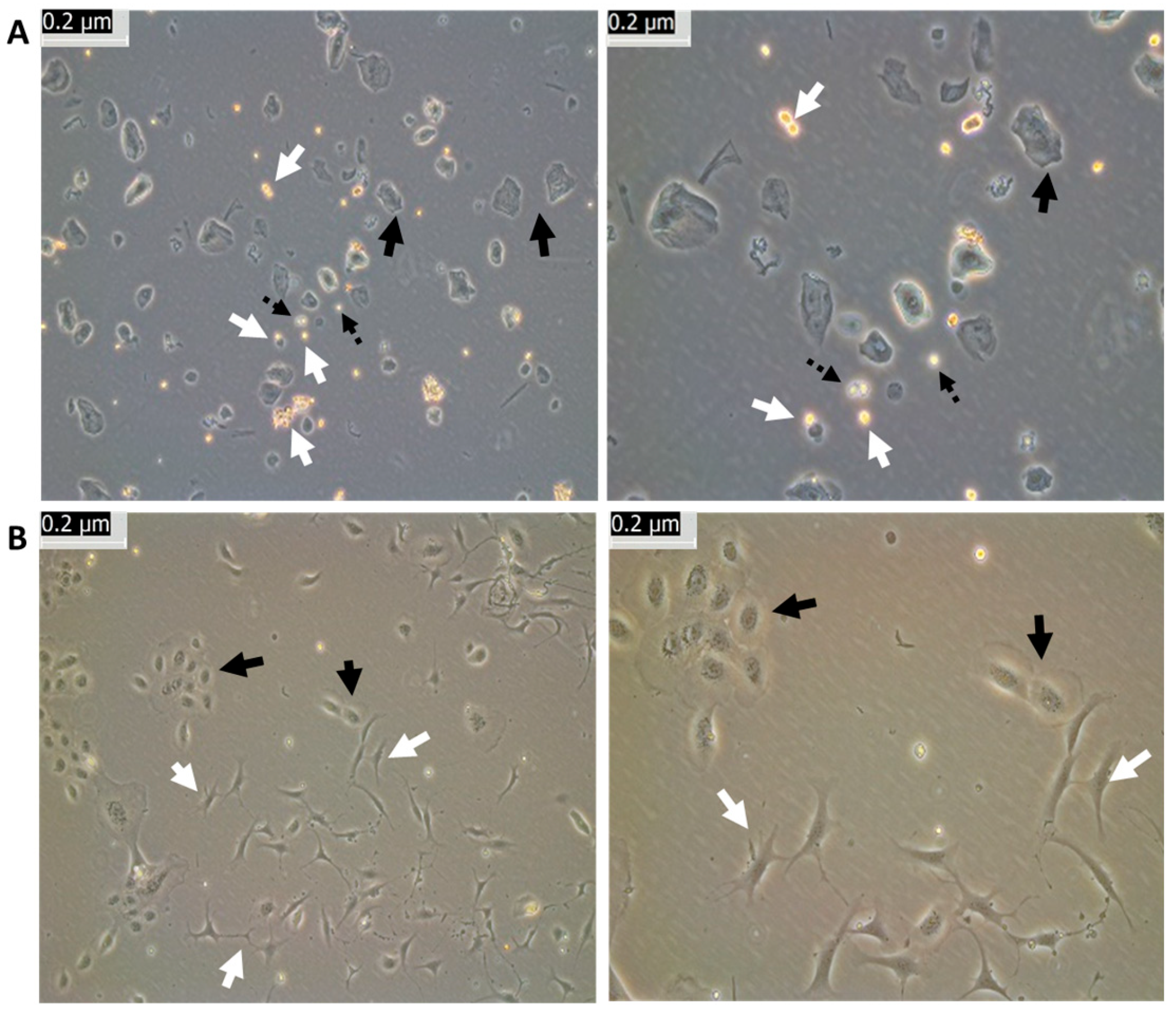

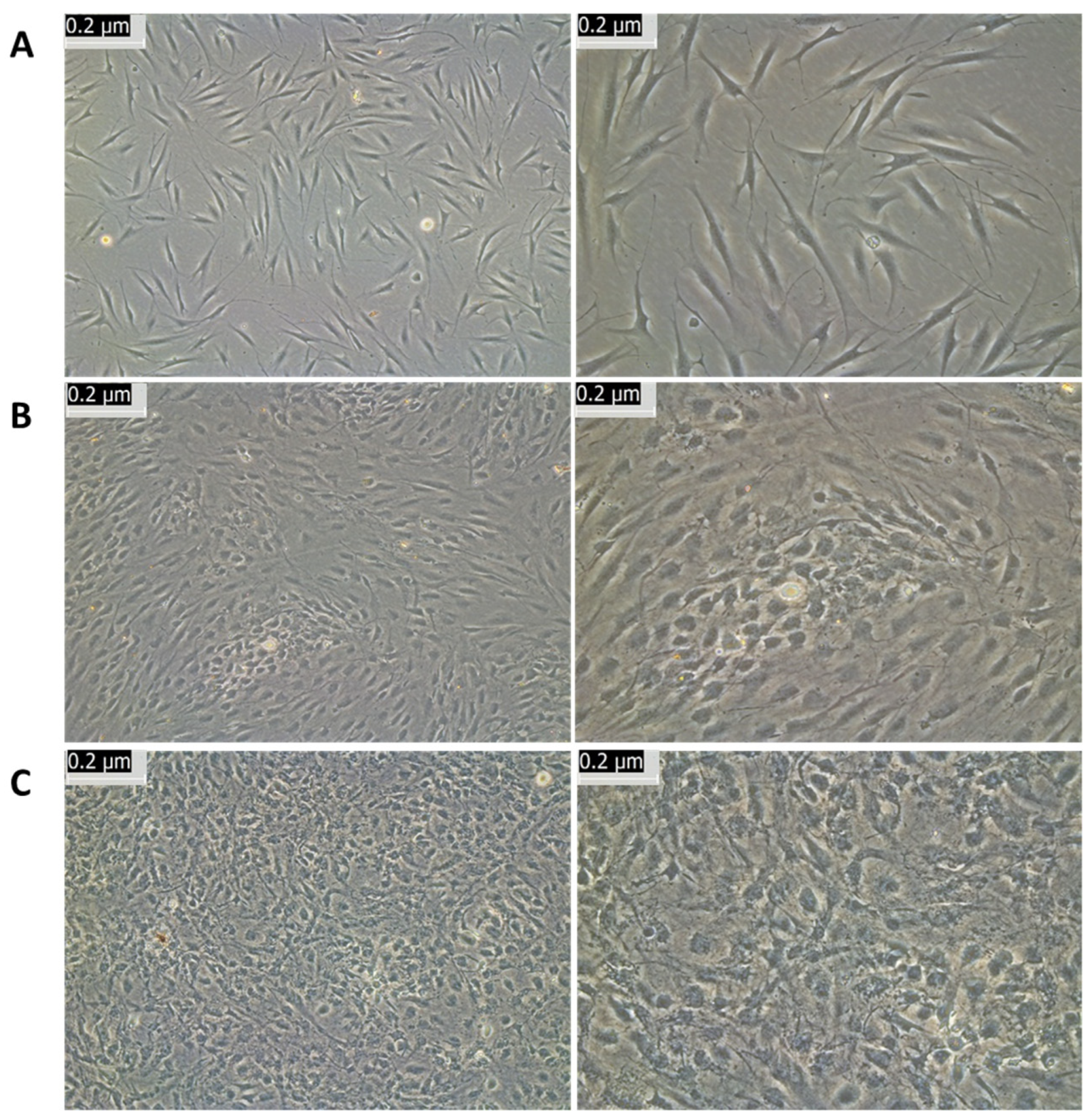

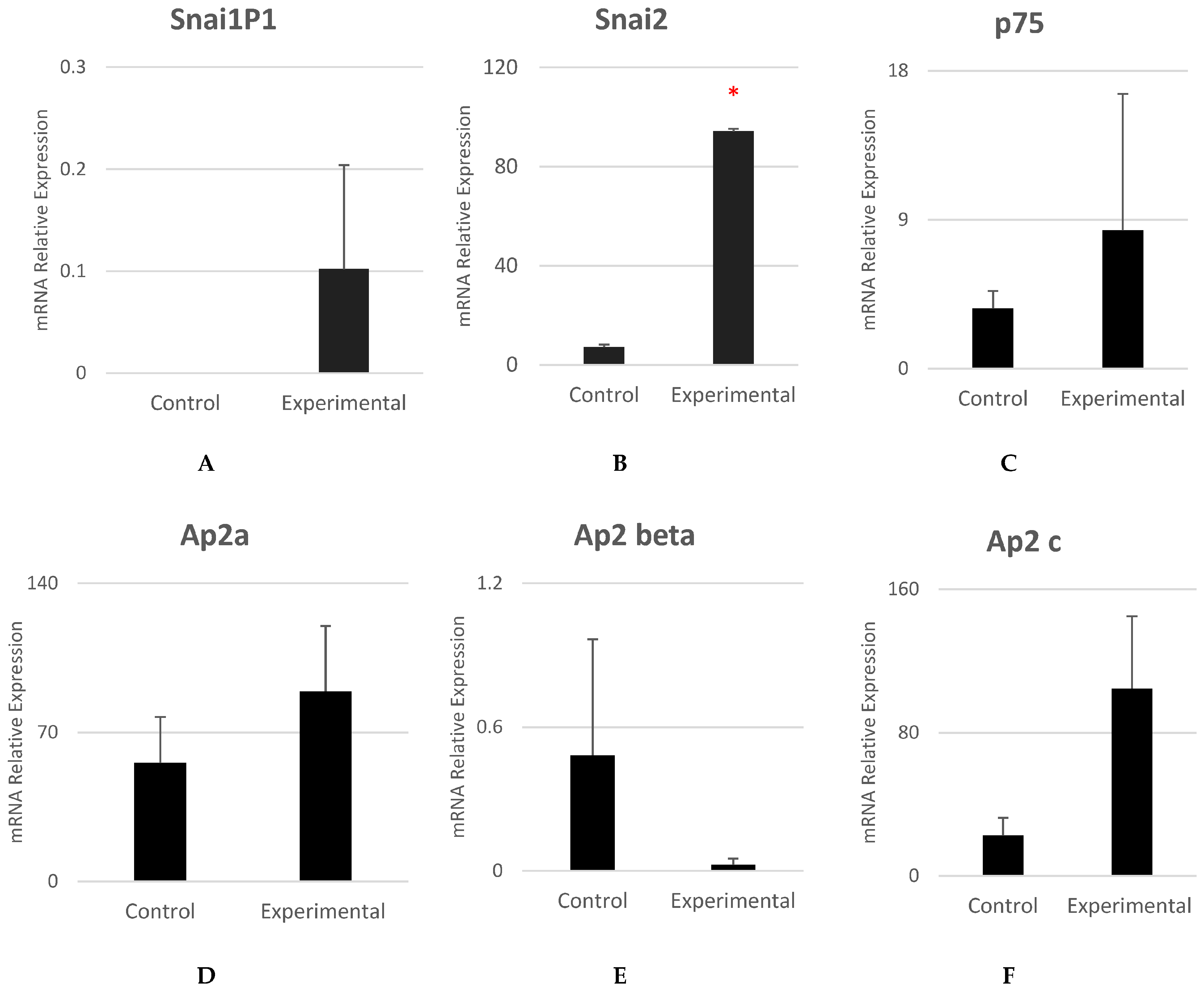
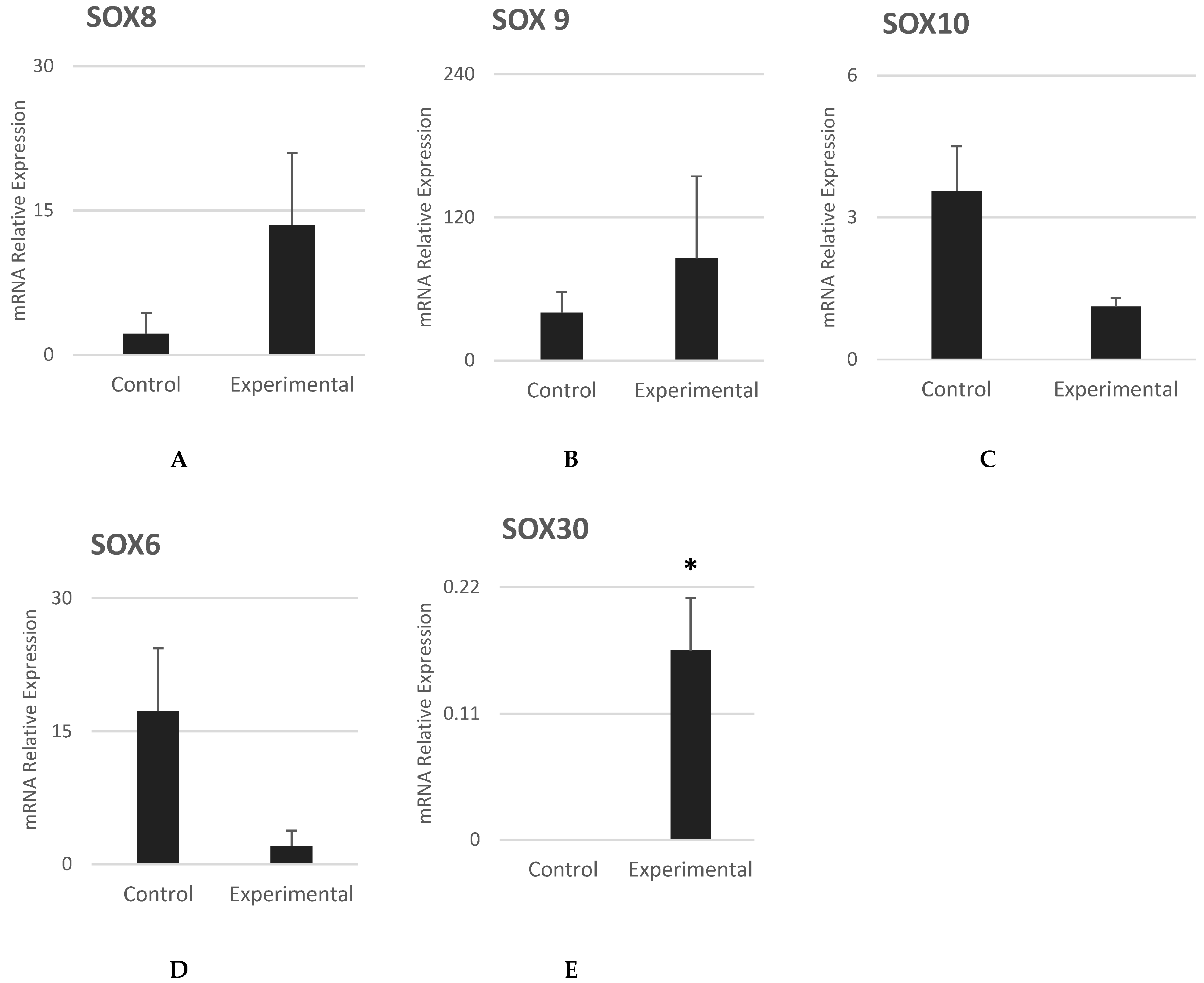

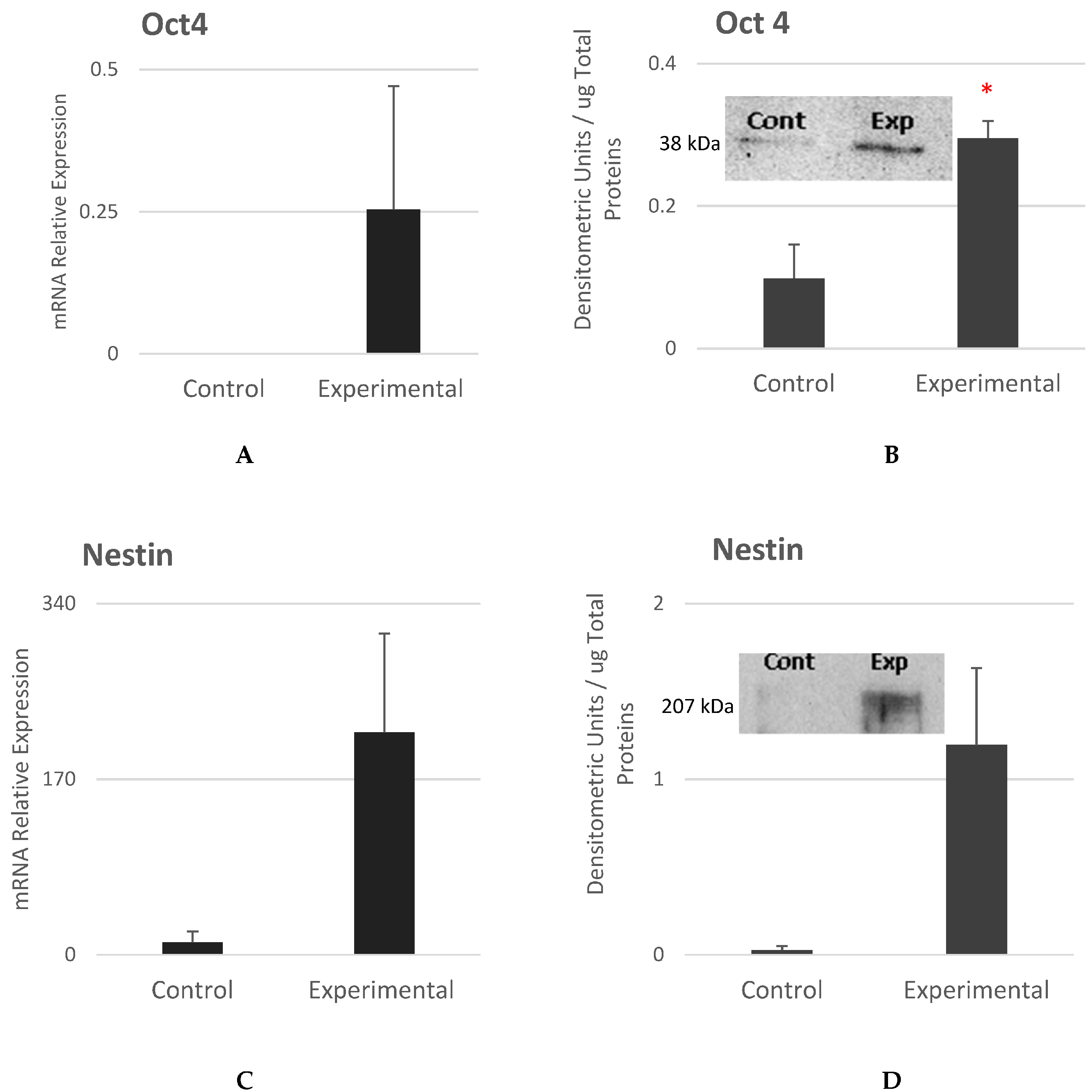
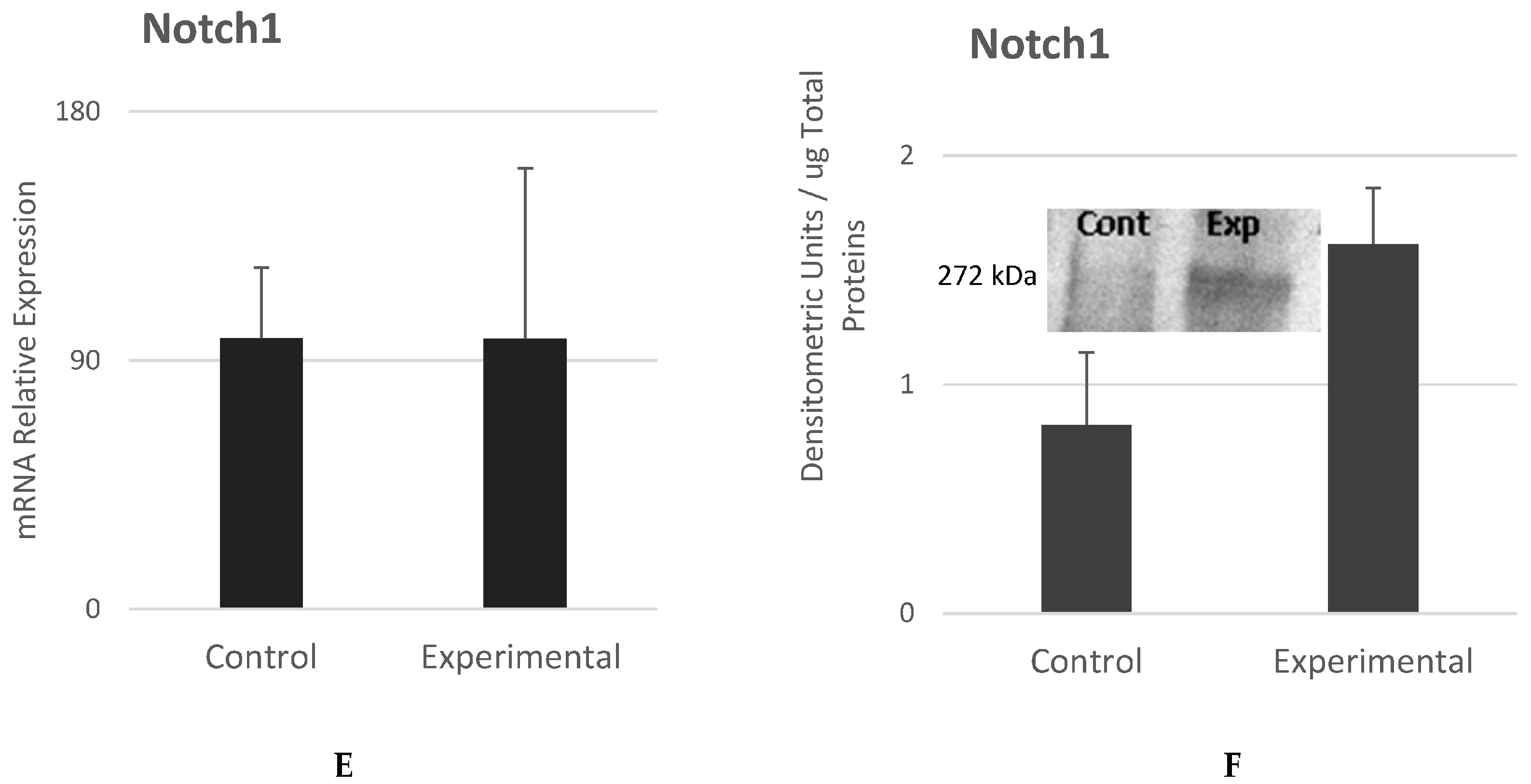
Disclaimer/Publisher’s Note: The statements, opinions and data contained in all publications are solely those of the individual author(s) and contributor(s) and not of MDPI and/or the editor(s). MDPI and/or the editor(s) disclaim responsibility for any injury to people or property resulting from any ideas, methods, instructions or products referred to in the content. |
© 2023 by the authors. Licensee MDPI, Basel, Switzerland. This article is an open access article distributed under the terms and conditions of the Creative Commons Attribution (CC BY) license (https://creativecommons.org/licenses/by/4.0/).
Share and Cite
Bardag Gorce, F.; Al Dahan, M.; Narwani, K.; Terrazas, J.; Ferrini, M.; Calhoun, C.C.; Uyanne, J.; Royce-Flores, J.; Crum, E.; Niihara, Y. Human Oral Mucosa as a Potentially Effective Source of Neural Crest Stem Cells for Clinical Practice. Cells 2023, 12, 2216. https://doi.org/10.3390/cells12182216
Bardag Gorce F, Al Dahan M, Narwani K, Terrazas J, Ferrini M, Calhoun CC, Uyanne J, Royce-Flores J, Crum E, Niihara Y. Human Oral Mucosa as a Potentially Effective Source of Neural Crest Stem Cells for Clinical Practice. Cells. 2023; 12(18):2216. https://doi.org/10.3390/cells12182216
Chicago/Turabian StyleBardag Gorce, Fawzia, Mais Al Dahan, Kavita Narwani, Jesus Terrazas, Monica Ferrini, Colonya C. Calhoun, Jettie Uyanne, Jun Royce-Flores, Eric Crum, and Yutaka Niihara. 2023. "Human Oral Mucosa as a Potentially Effective Source of Neural Crest Stem Cells for Clinical Practice" Cells 12, no. 18: 2216. https://doi.org/10.3390/cells12182216
APA StyleBardag Gorce, F., Al Dahan, M., Narwani, K., Terrazas, J., Ferrini, M., Calhoun, C. C., Uyanne, J., Royce-Flores, J., Crum, E., & Niihara, Y. (2023). Human Oral Mucosa as a Potentially Effective Source of Neural Crest Stem Cells for Clinical Practice. Cells, 12(18), 2216. https://doi.org/10.3390/cells12182216





